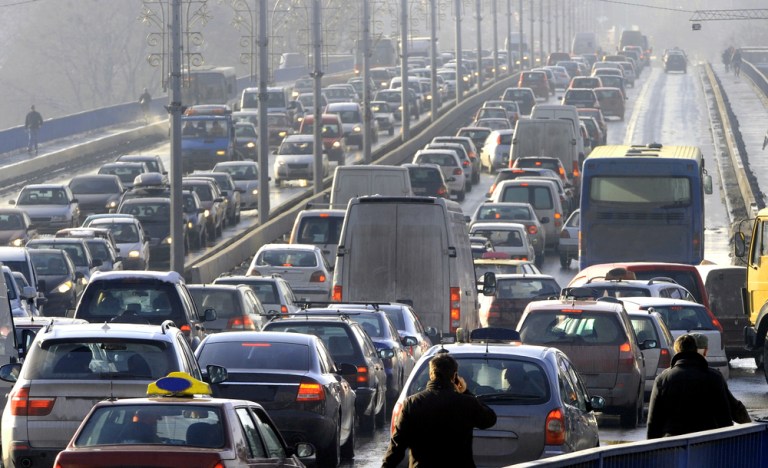Moovit CEO: How Mobility Data Makes Cities Smart

Just like cars on a highway at rush hour, transformation in city and infrastructure planning is not moving fast enough to get people where they need to go — and it’s about to become more of a problem, if Moovit Co-Founder and CEO Nir Erez is correct.
“The changes in the way people move in the city over the next five to 10 years will be more dramatic and aggressive than they were in the past 100 years,” Erez predicted.
While the technology exists to build a digital city “from the internet up” (Google’s parent company Alphabet is doing it in downtown Toronto), not every city can get the Google treatment. The time and costs are simply too great. Cities are desperate for solutions now, said Erez — solutions that can carry them into the future and shape the way people live and work, instead of letting worsening commutes shape the way workers live.
From autonomous vehicles to public and shared transportation, Erez said cities are going to have to get creative about how people move into, out of and through these urban centers.
The Long Game
Erez said there are two ways to improve transit: to build more of it or to make existing resources go further by thinking outside the box. The first option, he said, is difficult and expensive. The second, however, is achievable once city planners truly understand the state of affairs driving demand.
Such understanding, Erez said, cannot be achieved through representative surveys. These show how a fraction of commuters feel about the system on a single day, or maybe on a handful of days. Such a sample is not “data,” said Erez. City planners need to know how demand changes based on time of day, day of the week, changing seasons and weather factors, such as sun, rain or snow.
That’s the sort of information he said Moovit collects and shares with planners in cities all around the world as they prepare for the upcoming transformation. In a recent interview with PYMNTS’ Karen Webster, Erez shared how data can help cities plan for short-term needs as well as look ahead to the middle- and long-term shifts that are looming.
There are many opportunities for cities to improve infrastructure without increasing it. Erez said better utilization of existing infrastructure is a faster, cheaper first step than starting from scratch — plus, it can deliver results sooner for people whose commute times have gone beyond negatively impacting their lives to actually becoming unfeasible.
However, in the long term, he said cities must prepare for a transportation era dominated by autonomous vehicles. Like the rest of city planning, this shift must be data-driven based on the patterns and needs of commuters.
More Than a Workaround
People are adjusting to living in a world of inadequate infrastructure, but in many cases, they’re just finding the best workaround they can. They’re gaming the system in a way that makes them feel better without actually contributing to an overall solution.
Webster admits she’s among these ranks. She said her commute from 13 miles outside Boston can take well over an hour some days. Now, she said, she has contracted with a daily driver so she can at least get work done while sitting in traffic.
However, said Webster, her solution only helps herself; it doesn’t reduce the number of cars on the road and doesn’t help solve the problem of congestion.
Erez said the era of autonomous vehicles will change that. But getting there will be about more than replacing human drivers — it will also be about shuffling commuter hours and methods to optimize usage of available transportation resources.
Getting from Point A to Point B
Erez said higher pricing at rush hour could encourage some workers to travel earlier or later, reducing demand on the system during peak hours.
One starting point would be to charge commuters by miles traveled, or to introduce different ride fees for different times of the day — if those miles are consumed during rush hour, said Erez, then it makes sense for them to be more expensive, just like Uber trips during peak hours are subject to surge pricing.
Also like Uber, Erez said it makes sense to give customers the option to lower the cost by sharing rides — an option that could, in fact, make a dent in the number of cars on the road.
All of that may sound complicated, but with GPS and 4G transmitter technology, Erez said charging by the mile is easy — Uber and Lyft do it every day — while other innovations could support more flexible pricing and charging systems that could be used to balance the modes.
Of course, autonomous vehicles alone won’t solve all of the problems with growing urban populations. Bigger, better public transit systems may be part of the answer. It will also be up to individual governments how strictly they want to enforce the regulations they choose. Will they restrict movement of all private vehicles, simply increase parking fees or introduce charges at peak hours?
Again, Erez said, these decisions all come back to the data.
“We’ve got to force people to change some level of their behavior, or we’ll all be stuck,” he said. “We bring more data to the table to make change less painful and create a situation where people can change their habits without dramatically suffering.”
“The physics of transferring people into the city won’t change dramatically,” Erez admitted. “Four to 5 billion people live in crowded cities around the world, and they need a solution in the next couple of years. If you need to transfer X people into the city, the balance between mass transit and smaller form factors will have to change.”